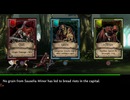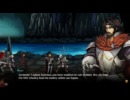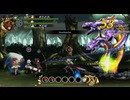
YummyYummyTummy's Fallen Legion is a 2D fantasy RPG coming in both handheld and console forms. Harry Papadimitriou was able to try out the game at E3 and learn more about the unique stories in each version.
---
Fallen Legion is a very interesting game with a unique way to tell a story. The game will be simultaneously released on PlayStation 4 and PlayStation Vita on July 25, 2017, but each system will get a different version of the game. Both versions tell the same overall story, but in the PS4 version you play as Princess Cecille, while in the Vita version you play as her enemy, Legate. As you might imagine from this description, the game's story is complex and deep, without clear good and evil characters. Both Legate and Cecille want to save their kingdom, but they each follow different paths to achieve that goal that put them directly at odds. Playing the story from the perspective of either character will make the other appear as bad, but experiencing both sides of the story will offer a more cohesive and clearer view on motives and events that drive characters. In many ways, this description immediately reminded me of Suikoden II's story, in which both the protagonist and Jowy are working toward the same goal. Suikoden II's shoes in this regard are quite hard to fill, but having Ben Bateman — editor of the acclaimed Zero Escape: Virtue’s Last Reward — as the writer means Fallen Legion may just be able to deliver on that.
In addition to the two-sided plot, Fallen Legion features a story with many middles. Players are often faced with many choices and actions, and they must deliberate on what they wish to do. Decisions affect story outcomes but also provide stat boosts. For example, players may have to choose whether or not to steal an item from someone innocent in order to help defeat an enemy attacking an entire village. Different actions will affect how many events unfold in the game. Some actions may lead to an NPC being an ally helping you in battle, while others may lead to him being an enemy that shows up as a boss. Different levels and paths may become available based on some player decisions. While all of these middles will likely lead to the same endings, they offer great variety to how the narrative unfolds from one moment to the next, and to the effects player decisions can have on different parts of the story. The developers seemed genuinely excited about this mechanic but were reluctant to reveal the types of things that were possible with it. Their stated hope is for players to wonder which of their actions lead to events unfolding a certain way versus another, and having a community driven to uncover how and why the story path branches in the various ways that it does.
In addition to the strong narrative focus, the game's second but equally prominent focus is the combat system. Here the game is heavily inspired by Valkyrie Profile, another comparison that provides large shoes to fill. Battles happen in real time, with one main characer — either Cecille or Legate depending on which version of the game you have — and up to three summoned characers selected from a larger pool, exactly like Valkyrie Profile's summoned einherjar. On the Vita version, hitting the circle, cross, or square button will cause the corresponding character to attack. Characters have action points that are expended when attacking and automatically fill up over time. The main character can equip and use up to three spells — each on its own cooldown timer — which can be activated by holding the appropriate direction on the D-Pad and pressing the triangle button. These include abilities to do damage, heal allies, and revive those who have fallen. Hitting the L button blocks, and these can be timed on incoming enemy attacks to perform perfect guards that provide additional action points and can open up various combat opportunities. In addition to variety offered by the different playstyles of the various summoned characters, each can be further customized by equiping gemstones that can be earned through game progress. These are semi-randomly generated upon completing an area, meaning that there is some logic as to how their effects are chosen, but the developers want to leave it up to the players to figure out exactly what these rules are.
  
In the demo, I faced off against two different bosses. The battle mechanics worked well to create a tense, highly active combat experience. It's not enough to simply use all your attacks as fast as possible in order to win against bosses, so it's by no means a button mash competition, even though you will be pressing buttons quite fast. For example, one of the bosses I fought reflects ranged damage with one of its abilities, so attacking with ranged characters while that ability is in use is massively detrimental. At other times the boss performed attacks that should be perfectly guarded to prevent large damage bonuses, so having the front character busy in an action and unable to block was suboptimal. Bosses can also be 'broken' if certain conditions are met, some of which can be inferred from battles themselves while others may be found as hints from NPCs or other game locations. The developers described it as a bit of a puzzle to figure out how to break bosses, and not as something that is necessary to win. However, when successfully done, bosses are stunned for an extended period during which all player characters have infinite action points and can unleash continuous damage. Furthermore, breaking bosses can happen multiple times in a battle, so this mechanic, while not required for victory, can significantly contribute to making fights more manageable.
The combat ends up being quick but highly intentional button presses in reaction to what enemies are doing, and eventually players get into the rhythm of how each enemy acts and can more effectively fight it. I found it highly demanding of my attention, and attempting to hold a conversation with the developers as I played lead to missed blocks, neglecting to heal on time, and even dying. As a first time player I found it a bit difficult to read all of the things going on in the visually dense action, and this was exacerbated by the Vita's small screen. As a result, I was not immediately able to effectively use the system to its full extent. However, it was also clear that with practice and learning to efficiently parse and react to the constant stream of visual stimuli, I would be able to fight much more effectively.
Unfortunately, the game doesn't feature much in the way of exploration. While players have choice in how the narrative unfolds and which areas they may tackle, the areas themselves are just a series of battles. There is no walking through them, picking up items, etc. Rather, the series of consecutive battles is sometimes interrupted by a timed choice like those mentioned earlier in the writeup, but other than that, it's just straight combat until the boss. The world map is a series of nodes of available areas that players can move between and select where to go next, so again, no real exploration of any kind here either. For me this does take away from an immersive experience, but a strong narrative can readily make up for this.
Visually the game looks great, and its aesthetic can be best be described as a less extravagant version of Dragon's Crown. It's also a bit darker, and character sprites are less stylized, and here the game once again reminded me of Suikoden. I found the somewhat simpler designs to be important for gameplay, reducing visual clutter to assist in parsing the fast-paced combat mentioned in the previous paragraph. I also found the darker atmosphere to be quite compelling, instilling a sense of somber seriousness to the backstory of a failing and decaying kingdom.
Overall, Fallen Legion chooses to focus on its narrative and combat, and offers a number of innovations in both of these areas. The promise of a two-sided story sounds complex and deep, and I look forward to seeing if the writers deliver on this promise. It's somewhat of a shame that those who don't have both a PlayStation 4 and a PlayStation Vita will be missing out on the complete experience though, and I sincerely hope the developers can do something for those players. The game does lack exploration, and it wasn't clear to me from the demo just how much customization would be available, but those things may not be necessary in an experience focused around fast but purposeful action, decision making, and deep story telling.
|









